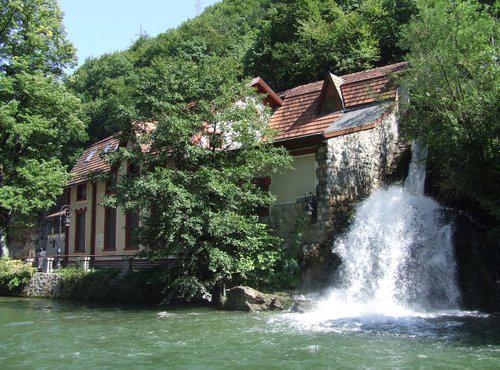
Hydroelectric Power and the Can Do Attitude
By Keith D. Foote

Hydroelectric power is one of the simplest, most efficient, cost effective ways of supplying electricity to your home. And sadly, as you may be aware, many of the dams providing hydroelectric power were taken apart, or allowed to fall apart, because they could not compete with inexpensive fossil fuels available at the time. (In the 1950s and 60s, fossil fuels were very, very inexpensive.) Fortunately, this has not stopped a small number of homeowners from taking advantage of hydroelectric power.
Most electrical generators need some form of kinetic energy to generate electricity. Kinetic energy turns the generator to make the electricity. With hydroelectricity, the kinetic energy comes from large amounts of flowing water. For over 100 years, the simplest way to produce the amounts of flowing water needed to generate electricity was to build a dam. Dams stop the natural flow of a river or stream, and build a reservoir of water behind it. Unfortunately, large dams and reservoirs are often inappropriate.
For generating small amounts of electricity without building a dam, a small hydroelectric generator is often an excellent solution, especially when there is a fast-flowing stream nearby. A small-scale hydro system is normally made up of an enclosed water wheel, or turbine, which is spun by jets of high velocity water. The water is moved down slope to the generator through a long pipe called a penstock. Water moving through the penstock gains speed, and is aimed at the fan blades of the turbine by nozzles. The turbine spins, pressured by the high speed water. The turbine turns the generator, and the electricity begins moving through the conductor to be stored for future use in a bank of batteries. These hydroelectric generators are simple enough for some homeowners to build and install themselves.
Homes are filled with appliances using electricity. But what exactly is electricity? In essence, electricity is the flow of electrons within a conductor. Electrons are individual subatomic energy fields, very often found in both tight and loose orbits around an atomic core. The loose ones can be knocked free. We call free electrons moving through a conductor ?electrical current.?
Each individual electron radiates a minute negative electrical charge, and each individual electron is repelled by the poles of a magnetic field. A generator contains a number of powerful magnets, and when these magnets are moved, or when the generator turns, the electrons shift down the conductor. Because electrons repel each other when they get too close, all the loose electrons shift. When they shift back and forth, it is call alternating current. The wire transporting these shifting electrons can be wound into a tight coil with many turns, which is called a winding. Moving a magnetic field across the winding causes many more electrons to be to shift back and forth within a small space, resulting in a stronger electrical current.
Alternating current isn?t necessary for simple appliances, such as lamps and lights, but it is necessary for equipment using motors, such as table saws or blenders. Most household electrical current from the grid is alternating current. Appliances have been specifically designed to use it. Direct current, the kind that comes from batteries, has the electrons moving in only one direction. An AC inverter is needed to convert the stored direct current from the batteries to alternating current.
The people who build their own hydroelectric generators have a slightly different outlook on life. They typically don't invest in the stock market, they invest themselves. They buy tools. They take classes and learn a new skill (like welding or photography). They make improvements on their homes using their own skill and labor. They tend not to be perfectionists, and are often comfortable making a mistake or two per day. Sometimes those mistakes lead to good ideas. They are often ?hands on? people, and enjoy watching their projects take shape. They are a large segment of the American ?can-do? population. Very few are city dwellers.
One advantage of hydroelectric generators over photo-voltaic cells a consistent flow of electricity, 24/7. This means the battery bank only needs be large enough to provide the peak loads needed for starting motors and temporary heavy operating loads. (Solar cells don't collect energy at night, or on cloudy days. The batteries have to store power for nights and rainy days, while with hydro, you can count on continuous current production.)
Another significant advantage of hydroelectric generators over photo-voltaic cells is the cost ratio for equipment. An equivalent photo-voltaic system costs roughly 10 times as much as a hydroelectric generator. That is of course assuming you purchase all of the equipment you would need for a hydroelectric system. Some people have converted old washing machines into hydroelectric generators for under $300.00.
If you are up to setting up a hydroelectric generator, you will need a source of water (preferably higher than you are, so it can run downhill). You want the waters kinetic energy, so the faster it's moving, the better. Plumbing, which is outside, and may need to be buried to prevent freezing. (Or not, it is moving water and may not freeze. Depends on where you live.) A generator with a propeller. A drain, or some way to remove the spent water. A bank of batteries to store the electricity. An AC (alternating current) inverter. Some sort of switching mechanism to take you off the grid, and back on during an emergency, and/or a system to sell your excess electricity back to the grid. Best wishes on your new project.